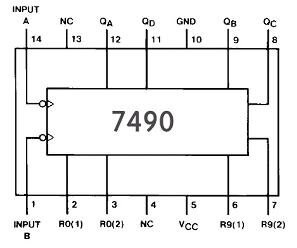| << Previous | Blog Index | Next >> |
|---|
In my first blog post I described the idea and plan of converting my old nixie pulse counter to a versatile number display.
My plan was based only on visual investigation of the hardware. In this post I will describe some test and measurements in order to get a solid plan for the conversion.
Nixie power
Member mads391i asked for the power rating of the nixie tubes. Although not completely necessary to know for the purpose of the project, it is always good to have a good feeling of how the circuit works. Here is a picture of the bottom side of the PCB. As you can see a very clean and comprehensible design from which the circuit easily can be derived.
Here is the circuit I deduced from the PCB:
Then I measured the Vcc voltage, which drives the TTL logic:
The Vdd voltage, which drives the nixie tubes:
And the voltage across the 39k resistor, which appeared to be 85V. 85V over the 39k resistor is 2.2 mA current trough the resistor and nixie tubes. Total power consumed by the nixie tube, resistor and 74141 per digit is 225 x 2.2 = 495 mW, so almost half a Watt. And for all six digits 3 Watt in total excluding the rest of the logic.
BCD Decoder
Now some words about the coding of the numbers. The 7490 counters outputs BCD code to the 74141 BCD-DECIMAL decoder/driver IC. BCD takes advantage of the fact that any one decimal numeral can be represented by a four bit pattern, where each decimal digit is represented by its corresponding four-bit binary value, as shown in the following table, copied from the 74141 datasheet.
As can be seen from the picture of the backside of the PCB the BCD outputs of the 7490 counters are connected to separate connections on the PCB where eventually pin headers or wires can be soldered.
In order to test the BCD inputs on the 74141 drivers I removed one of the 7490 counters. Since an open input in TTL logic counts as a logical H, according to the table we expect to have no output.
Unfortunately due to parasitic effects all the digits light up a bit.
This means that with the current circuit I'm not able to turn a digit completely off.
Then I connected the GND (7490 pin 10) to output D (7490 pin 11). And bingo, a nice 7 appears on the display, as expected from the above function table.
So by providing proper BCD codes to the 7490 sockets I can easily select the different numbers.
Member jasonwier92 suggested to let the SN 7490 in place and control the digits with pulses. I like the idea, but drawback is that each time you change a digit you will have some counting effect on it. Furthermore I expect by replacing the 7490's with a small circuit board with an I/O extender will give a more clean and solid solution.













Top Comments
-

mcb1
-
Cancel
-
Vote Up
0
Vote Down
-
-
Sign in to reply
-
More
-
Cancel
Comment-

mcb1
-
Cancel
-
Vote Up
0
Vote Down
-
-
Sign in to reply
-
More
-
Cancel
Children